Mother Series © Copyright 2018 | Jennifer Georgescu
"The scholarship is open to photographers who have produced individual works of photography and/or are in the process of producing bodies of work. We are looking for candidates who are serious about photography, whose potential is emerging and whose photography will benefit from this scholarship. Candidates can be currently enrolled in a photography degree program if in their graduating year. There is no age limit. There are no residency requirements. There is no application fee.
Photographers without gallery representation who have not exhibited solo in a commercial gallery, academic gallery (except for thesis shows), galleries in organizations like the Griffin Museum, Houston Center for Photography, Center for Fine Art Photography etc. or a museum setting or have not received significant (over $3000) grant funding are eligible (coffee shop, community gallery, library, academic thesis exhibitions, etc. are eligible exhibition settings). Past awardees of the Chervinsky Scholarship, paid employees of the Griffin Museum or their immediate families, Griffin Museum board members and jurors’ immediate families and those immediate families of Griffin board members or jurors’ paid employees are not eligible.
This scholarship is not for well-established photographers. Well-established photographers are individuals in mid-photography-careers and are seen by the public and peers as distinguished in the field of photography and have many accomplishments as a photographer. Of note, receiving a Fulbright Scholarship would disqualify a candidate from receiving this scholarship. Producing a published (by a publisher) photo book would disqualify a candidate from receiving this scholarship. Self publishing does not disqualify a candidate." See more on Griffin Museum of Photography website.

















